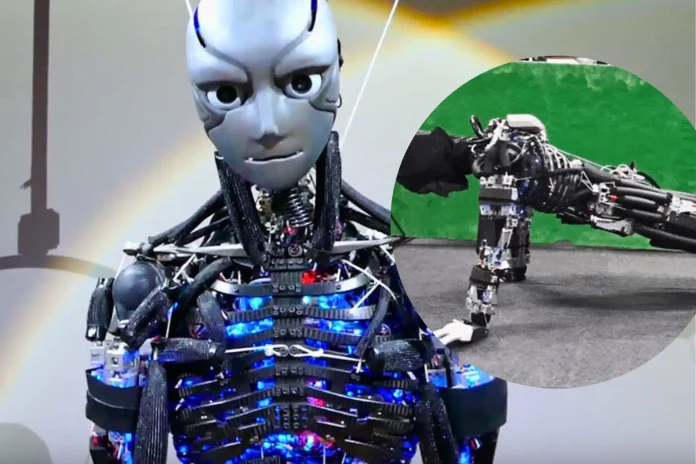Imagine a robot that can do push-ups and sit-ups and even hit a badminton racket that mimics human anatomy and even “sweats” to cool down instantly. This is all possible with Kengoro Robot, the latest wonder from the University of Tokyo’s GSG lab.
Developed by a team led by Professor Masayuki Inaba, Kengoro is more than just a technological marvel. It represents a significant step in human-mimetic robotics, offering insights into human movement and potentially making the way for future advancements in prosthetics, rehabilitation, and even disaster response.
Kengoro Robot is Built to Move Like a Human
Kengoro stands 1.7 meters tall and weighs 56 kilograms, roughly resembling a teenage boy. But beneath its skeletal frame lies a complex network of 114 degrees of freedom (DOF), which is 27% of the number possessed by humans and the highest among life-sized humanoids. This allows Kengoro to move with remarkable fluidity and perform various motions, including full-body exercises and basic sports activities.
But Kengoro’s true innovation lies in its “muscles.” Unlike traditional robots powered by rigid motors, Kengoro uses a system of 108 brushless DC motors that mimic the action of human muscles. These motors are strategically placed throughout the body, replicating the major muscle groups and their interactions.
Related: Ameca Robot with Human-like Facial Expressions
Sweating Robot for Better Efficiency
One of the most fascinating aspects of Kengoro is its “sweating” mechanism. Due to the high number of motors and their constant activity, Kengoro generates heat, just like a human during exercise. However, unlike humans, robots don’t have built-in cooling systems.
To address this challenge, the researchers came up with a unique solution. Kengoro’s “skin” is made of a microporous material that allows water vapor to escape from tiny holes. As the motors heat up, water from within the robot evaporates through these pores, creating a cooling effect similar to human sweating.
The Potential of Kengoro Robot
While Kengoro’s ability to mimic human movement is impressive, the potential application goes far beyond just its gym routines. Professor Inaba explains, “Our goal is not just to make humanoid robots that can move but to understand the underlying principles of human movement and extend these implications to solve real-world problems.”
One potential application lies in developing advanced prosthetics for humans and robots alike. By understanding how muscles interact to create movement, researchers could design prosthetics that offer greater functionality and control to amputees. Additionally, Kengoro’s ability to perform complex movements could be valuable in rehabilitation, helping patients regain lost motor skills.
Furthermore, the insights gained from Kengoro could be used to design robots for disaster response. These robots could navigate challenging lands, perform search and rescue operations, and even assist in reconstruction efforts.
Related: How Aloha Robot Handles All Household Tasks
Challenges in the Production of Sweating Robot
Despite its impressive capabilities, Kengoro is still under development. One major challenge is the complexity of the system. With 114 DOFs and 108 motors, Kengoro requires heavy computational power to control its movements. Additionally, while innovative, the “sweating” mechanism is still in its early stages and requires further refinement.
However, the researchers are optimistic about the future. “Kengoro is just the beginning,” says Professor Inaba. “We believe that this research has the potential to revolutionize the field of robotics and lead to the development of robots that can truly interact with and assist humans in various ways.”
Kengoro Robot is more than just a simple robot that can do push-ups and sweat. It is a critical step towards the future of human-mimetic robotics, offering valuable insights into human movement and making the way for future advancements in various fields. While challenges remain, Kengoro’s potential is undeniable, and it will be exciting to see how this innovative robot shapes the future of robotics and its impact on our lives.



